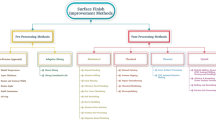Abstract
Fused deposition modeling (FDM) is the most widespread 3D printing technology. The primary reasons for this are its simplicity in manufacturing and low cost. The common issue of FDM is an anisotropic property of the extruded layer. Therefore, the mechanical strength of traditional machining methods is significantly better than FDM-fabricated parts. Implementation of diode laser (450 nm) with 5 W power for localized heating of the pre-deposition layer is proposed to overcome this problem. The laser power is controlled during the printing process. Thereby, layer interface temperature reached for critical point, where the bonding diffusion process between layers increased for the maximum level. The effect of the pre-deposing heating method is presented at different laser power values and printing speed. Tensile test results on PLA (polylactic acid) plastic specimen indicate a 10.16% increase in ultimate tensile strength at 2.84 W power of the laser. However, crack and hole formations indicate a negative result of intensive laser heating employment.















Similar content being viewed by others
References
Li H, Wang T, Sun J, Yu Z (2016) The effect of process parameters in fused deposition modelling on bonding degree and mechanical properties. Rapid Prototyp J
Mohamed OA, Masood SH, Bhowmik JL, Nikzad M, and Azadmanjiri J (2016) “Effect of process parameters on dynamic mechanical performance of FDM PC/ABS printed parts through design of experiment,” J Mater Eng Perform, no. Ref 7
Gebisa AW and Lemu HG (2018) “Investigating effects of fused-deposition modeling (FDM) processing parameters on flexural properties of ULTEM 9085 using designed experiment,” Materials, MDPI.pp. 1–23
Vosynek P, Navrat T, Krejbychova A, and Palousek D (2018) “Influence of process parameters of printing on mechanical properties of plastic parts produced by FDM 3D printing technology,” 2014:1–6
Popescu D, Zapciu A, Amza C, Baciu F, and Marinescu R (2018) “FDM process parameters influence over the mechanical properties of polymer specimens: A review,” 6:157–166
Chung C, Lin WT, Wang CC, Lin T (2007) Optimizing the rapid prototyping process by integrating the Taguchi method with the Gray relational analysis,
Yang C, Tian X, Li D, Cao Y, Zhao F, Shi C (2017) Influence of thermal processing conditions in 3D printing on the crystallinity and mechanical properties of PEEK material. J Mater ProcessTech 248:1–7
Kuznetsov VE, Solonin AN, Tavitov AG, Urzhumtsev OD, and Vakulik AH (2018) “Increasing of strength of FDM ( FFF ) 3D printed parts by influencing on temperature-related parameters of the process,” no. April, pp. 1–32
Fitzharris ER, Watt I, Rosen DW, and Shofner ML (2018) “Interlayer bonding improvement of material extrusion parts with polyphenylene sulfide using the Taguchi method,” Addit. Manuf
Coogan TJ, Kazmer DO (2017) Bond and part strength in fused deposition modeling. Rapid Prototyp J 23(2)
Yin J, Lu C, Fu J, Huang Y, Zheng Y (2018) Interfacial bonding during multi-material fused deposition modeling ( FDM ) process due to inter-molecular diffusion. Mater Des 150:104–112
Yan Y, Zhang UR, Hong G, Yuan X (2000) Research on the bonding of material paths in melted extrusion modeling. Mater Des:93–99
Kishore V et al (2017) Infrared preheating to improve interlayer strength of big area additive manufacturing (BAAM) components. Addit Manuf 14:7–12
Partain SC (2007) “Fused deposition modeling with localized pre-deposition heating using forced air”, Master’s Thesis, Montana State University
Luo M, Tian X, Zhu W, Li D (2018) Controllable interlayer shear strength and crystallinity of PEEK components by laser-assisted material extrusion. Mater Res 33:11
Jun D, Zhengying W, Xin W, Jijie W, Zhen C (2016) An improved fused deposition modeling process for forming large-size thin-walled parts. J Mater ProcessTech 234:332–341
Ravi AK, Deshpande A, Hsu KH (2016) An in-process laser localized pre-deposition heating approach to inter-layer bond strengthening in extrusion-based polymer additive manufacturing. J Manuf Process 24:179–185
Ash C, Dubec M, Donne K, Bashford T (2017) Effect of wavelength and beam width on penetration in light-tissue interaction using computational methods. Lasers Med Sci 32:1909–1918
Acknowledgements
Authors sincerely express their gratitude to Nazarbayev University for this research grant. The award number is 090118FD5327. Due to the financial support, the research activities are carried out successfully.
Author information
Authors and Affiliations
Corresponding author
Additional information
Publisher’s note
Springer Nature remains neutral with regard to jurisdictional claims in published maps and institutional affiliations.
Rights and permissions
About this article
Cite this article
Sabyrov, N., Abilgaziyev, A. & Ali, M.H. Enhancing interlayer bonding strength of FDM 3D printing technology by diode laser-assisted system. Int J Adv Manuf Technol 108, 603–611 (2020). https://doi.org/10.1007/s00170-020-05455-y
Received:
Accepted:
Published:
Issue Date:
DOI: https://doi.org/10.1007/s00170-020-05455-y




